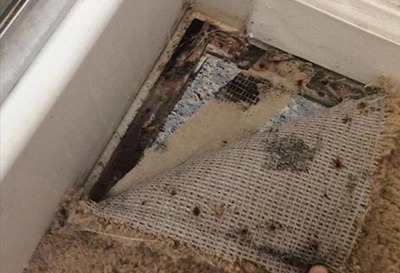Types of mould and how to remove it safely

The onset of mould in the home can be one of the more upsetting things that could happen. Apart from the odour and the unsightly visual it can cause if left untreated, it can also pose a whole bevy of health issues.
Mould, and its cousin mildew, can even occur in the most well looked after of interior spaces, and it really does not take much for these two to appear. Dampness from a particularly humid day, a water stain that has been left untreated, or even rotten tile grout can all contribute to create an area where mould and mildew can thrive.
Whilst mould is largely a product of itself and doesn’t really differ in type, it does take on differing properties, depending on the material that you find it on. Mould found in carpet, for instance, can be relatively simple to remove, whilst those present in timber flooring or structures can be a little bit more difficult to eliminate.
Don’t worry, however, as in this article we will be going through the types of mould, associated with common household materials, and how you can remove it before it spreads or turns into something worse.
Whilst there is no substitute to hiring a professional household cleaner to safely remove the mould, these little tips and tricks will at least get your home looking as good as new.
Contents
First off, what exactly is mould?
Mould is a fungus that finds a home in many organic substances. Spilt liquids and foods in carpet or even large presences of dampness in the air is all it takes for a suitable growth atmosphere.
As mould itself is an organic substance, it will seek to grow. This growth will mean that it will seek to spread, or to become larger, and not necessarily either one.
This means that smaller traces of mould could potentially be more dangerous, so don’t fall into the trap of thinking that a small catchment of mould is harmless and doesn’t require urgent attention.
Mildew, which is commonly attributed as an onset of mould, is in fact a slightly differing strain of mould. Mildew is perhaps more aggressive in consuming organic matter around it, and can quickly erode materials such as wood, cement, mortar, or grout.
Mould found in carpet
Mould that is present in carpet is perhaps one of the more common places where you can find it, second only to tiled surfaces in the bathroom. Mould in carpet will have a very distinctive appearance, and will showcase a particularly bad smell, so you won’t miss it.
One common mistake that many make when removing mould is to think that using common cleaning substances can remove it. If the substance in question is heavily water based, it can actually make things worse.
The key to removing mould in carpeted areas is to make sure that any dampness is removed from the room. This means that all available windows should be opened, any doors that might help do this as well should be likewise opened, and if you have any dehumidifiers or air purifiers handy, now is the time to turn them on.
Using the old trick of salt and vinegar, apply this to the area and dab gently with a sponge. Make sure that any standing water around the mould affected area is completely dry by pressing down with a dry cloth to draw the water out, and leave overnight.
The mould should begin to noticeable recede, if not be completely removed. It may help to go over the area with a vacuum cleaner as per your usual cleaning routine.
Mould affected tiles
Mould is often found in areas such as the bathroom quite regularly, where warm baths and showers can create the perfect atmosphere. Mould traditionally affects any grout based surfaces in the bathroom, including shower tiles and floor tiles, and timber walls in a bathroom should be treated with extra care.
Unlike mould that attacks carpets, the presence of it can actually cause serious structural damage to your bathroom. Grout will be eaten away rather quickly, meaning your tiles could either become loose and even fall out of place.
Should mould be found in your bathroom, and even just as a general cleaning tip, dip a toothbrush or specialist little brush into vinegar, and brush all along the lines where the grout appears between the tiles.
If you have clove oil, you can also used this to remove any light staining that the mould will leave on the grout itself. Do this a couple of times, then use common bathroom tile cleaning products to remove any further trace of odour.
Mould attacking hardwood floors
Mould found on hardwood flooring can be a sign of either water damage or simply the age of the hardwood. Over time, this can rot away at the timber – maybe not enough to compromise the structure, but enough to leave the unsightly visual of rotten floors.
Again using vinegar, apply to an old cloth – preferably one that has some level of abrasiveness, and brush the affected area with long, broad strokes. An abrasive cloth or towel will help to remove the mould that can set deep in the timber, especially along natural features of the timber, such as the grain of the wood.
Clove oil can be used once more to mask the rotting wood and mould smell, utilising the same technique of broad strokes to cover every facet of the timber flooring.



